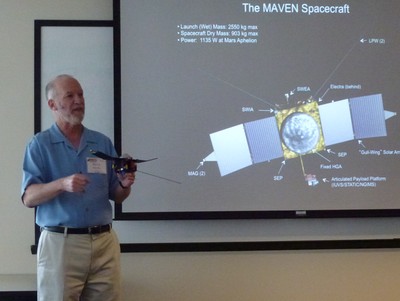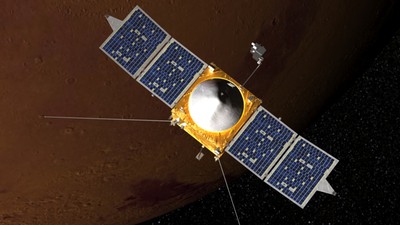Flying above the Martian radarby Jeff Foust
|
| “We pitched this not as an aeronomy mission, but as a mission to understand the geology and astrobiology of Mars,” Jakosky said of MAVEN. |
Yet, NASA’s next mission to Mars, slated to launch in just two and a half months, is a very different kind of spacecraft. The Mars Atmosphere and Volatile EvolutioN (MAVEN) mission is not a rover, and will pay little attention to the surface of Mars. It won’t even provide much in the way of pretty pictures of the Red Planet. MAVEN, an orbiter, will instead focus on the planet’s tenuous atmosphere and its interaction with the solar wind, seeking to understand how the atmosphere evolved over time.
This study of the Martian upper atmosphere, which MAVEN will perform primarily with spectrometers and a package of field and particle instruments, is known as aeronomy. Those behind the mission, though, prefer not to think of MAVEN as an aeronomy mission.
“We would never have been able to sell an aeronomy mission on the basis of doing aeronomy. Just bringing up the word, people fall asleep,” said Bruce Jakosky, principal investigator of MAVEN and a professor at the University of Colorado, during a workshop about the mission late last month held at the university’s Laboratory for Atmospheric and Space Physics (LASP) in Boulder. The team, he recalled, went so far as to make sure the word never appeared in the proposal for the mission submitted to NASA.
MAVEN, he and other team members argued, is not a mission to study the Martian atmosphere for its own sake but to probe more fundamental scientific questions about Mars. “We pitched this not as an aeronomy mission, but as a mission to understand the geology and astrobiology of Mars,” he said.
Scientists hope MAVEN will help them understand what happened to the Martian atmosphere. The planet once had a much denser atmosphere, one that allowed it to support liquid water on its surface early in its history—and, presumably, made it more hospitable to life. But what happened to that atmosphere remains a key unanswered question: how much of it was sequestered into the Martian crust, and how much was lost to space?
“We don’t know whether either of these processes was the dominant process in the history of the atmosphere,” Jakosky said. “The bulk of the effort over the last two decades has been looking at carbon dioxide in the crust. We’re going to provide the flip side of that, answering how important loss to space has been in the history of Martian climate.”
There’s already evidence that escape to space played a role in the loss of that initial Martian atmosphere. The ratio of deuterium to hydrogen in the Martian atmosphere is enriched in deuterium by a factor of five compared to the Earth. That hydrogen comes from water, which means Mars presumably lost much of its initial water to space. “Of order three-quarters of the water that was on the planet at one time is no longer on the planet,” Jakosky said. “It’s been lost to space.”
| “People who have worked a lot of projects have said that this is the smoothest development they’ve ever seen,” Jakosky said. |
MAVEN will measure the current rates of escape of atmospheric components to space, which will provide a better understanding of the processes that cause escape, including both thermal escape as well as interaction with the solar wind. It will do this by passing through the upper atmosphere at altitudes as low as 150 kilometers, with some “deep dips” down to 125 kilometers, coupled with more global measurements at its apogee of 6,000 kilometers. “We get detailed point measurements and we get global measurements to compare it to,” Jakosky said. “To me, that’s an incredibly powerful handle on understanding the structure, composition, and escape” of the Martian atmosphere.
MAVEN scientists believe that, by understanding the current escape rates of the Martian atmosphere and the processes driving them, they will be able to extrapolate back in time to see how big a role these mechanisms played in the evolution of the planet’s atmosphere. “If we understand the physics of each one of these processes, there’s no problem extrapolating back,” said Joseph Grebowsky, NASA project scientist for the mission.
One issue scientists hope MAVEN will address is the importance of planetary magnetic fields in shaping the evolution and habitability of planets. Mars likely had a magnetosphere early in its history but lost it as the planet’s interior cooled and the dynamo driving that magnetic field died, leaving behind only remnant fields locked in the planet’s crust. “It’s not a done deal that magnetospheres necessarily influence evolution of atmospheres,” said David Brain, a MAVEN co-investigator at LASP. “The bigger question for me is whether magnetic fields are ‘nice things to have’ for the habitability of a planet.”
“MAVEN, although it is a Mars mission, is really using Mars as the closest laboratory we have for understanding planets and habitability,” he added.
 MAVEN principal investigator Bruce Jakosky uses a model of the spacecraft to discuss the mission to participants of a workshop last month in Boulder, Colorado. (credit: J. Foust) |
Yet, for all the promise MAVEN has in understanding the Martian atmosphere and the prospects for past habitability there, the mission has gotten little attention to date, relative to other missions like Curiosity. It’s flown under—or perhaps, as an orbiter, over—the radar as Curiosity and Opportunity travel across the Martian landscape, and while planetary scientists fret about the future of Mars exploration, including the prospects of returning samples of Mars to the Earth, which remains a long-term goal of scientists.
One reason, perhaps, is that MAVEN has been a “no drama” mission so far, its development free of the major technical issues, cost overruns, and schedule delays that plagued Curiosity. Jakosky proudly noted at last month’s workshop that MAVEN has remained on schedule and budget—and, at $485 million, it’s also a small fraction of Curiosity’s estimated $2.5-billion cost.
“People who have worked a lot of projects have said that this is the smoothest development they’ve ever seen,” Jakosky said. He credits this to a lack of “requirements creep” during the mission’s development as well as no need for technology development to enable the mission. He also credited an experienced team working on the mission, as well as support from NASA’s Goddard Space Flight Center, LASP’s partner on MAVEN. ‘They’ve given us the ‘A team’ in their project office,” he said of Goddard.
“It could just be dumb luck, too,” he admitted.
Although the spacecraft’s development has gone smoothly, Jakosky is still nervous, now mostly about the launch. MAVEN will launch on November 18 on an Atlas V 401. There’s one Atlas launch before MAVEN, a mid-September launch of a military communications satellite. “I’m worried sick over that, because if it blows up, they’re not going to launch us without understanding what happened,” which would likely mean MAVEN would miss its launch window and have to wait two years to try again.
The Atlas V, of course, is a reliable rocket, and its manufacturer, United Launch Alliance, trumpets its perfect launch record since its introduction 11 years ago. But that perfection is not good enough for Jakosky: he notes that on one Atlas V launch, carrying the NROL-30 classified payload in 2007, the upper stage underperformed, playing the satellite into a slightly low orbit. The satellite was reportedly able to recover from that, but the situation would be different if that happened MAVEN. “If we have an underburn on the upper stage, we’re done,” he said.
| “I’m hopeful that this is not the last mission we send to Mars during my career that will look at these issues,” Lillis said, “because I think it is likely that we’ll discover something completely unexpected that will open up a whole host of other questions.” |
Assuming that launch goes well, followed by the insertion into Mars orbit in September 2014, MAVEN has a one-year prime mission, although the project hopes to keep MAVEN operating for as long as a decade, to study variability over the Martian year and over the solar cycle. Initial results on Martian atmosphere escape rates will come about three months into the mission, Jakosky said.
MAVEN carries more than just a scientific payload: it is also equipped with a communications package called Electra designed to relay data from spacecraft on the Martian surface to Earth. Similar radios are on the Mars Odyssey, Mars Reconnaissance Orbiter, and ESA’s Mars Express spacecraft currently in orbit, thus MAVEN’s radio won’t immediately be used. However, NASA anticipates that, particularly by the time the Mars 2020 rover arrives, that radio will be needed as those other spacecraft reach the end of their lives.
It’s possible that radio could be used sooner should something happen to those existing spacecraft, but that could create conflicts with MAVEN’s science mission. “It’s nice to have in our back pocket if we were to lose other orbital assets,” said Michael Meyer, lead scientist for NASA’s Mars Exploration Program, who participated in last month’s workshop via Skype. “If MAVEN ends up being the prime communications relay, it will be difficult to do all of the science MAVEN would like to do.”
The MAVEN science team wants to get as much science as they can out of the spacecraft because, for many of them, this may be their one opportunity to study the Martian upper atmosphere in detail. There are, for now, no plans by NASA to send another orbiter to Mars: after MAVEN, there is only Insight, a stationary lander to study the planet’s interior planned for launch in 2016; and the 2020 rover. (ESA will launch an orbiter to Mars in 2016 as part of its ExoMars program, now being done in cooperation with Russia after NASA backed out last year.)
“We recognize that, at some point in time, we do want to put in another orbiter,” Meyer said. “We’re just not talking about it right now because we are not in a budget environment where we have any hope whatsoever of starting the process” of developing another orbiter.
“This is definitely a once-in-a-career opportunity,” Brain said when asked during a workshop panel if they felt MAVEN was their one chance to address these questions about the Martian atmosphere. “If MAVEN is successful in answering its top-level science questions, then I think we’re going to have a very good constraint on what happened” to the atmosphere.
“I would agree that this is a once-in-a-career opportunity,” said Rob Lillis of the University of California Berkeley’s Space Sciences Laboratory, another MAVEN scientist. “I’m hopeful that this is not the last mission we send to Mars during my career that will look at these issues, because I think it is likely that we’ll discover something completely unexpected that will open up a whole host of other questions.”
That prompted Brain to revisit his original response. “If science questions are compelling enough, I trust in the system for mission selection—as faulty as it can sometimes appear from the outside—that compelling science receives missions,” he said. “If there’s compelling science that comes out of MAVEN that hasn’t been addressed, then I’m hopeful there can be a mission in the future to address that.”
